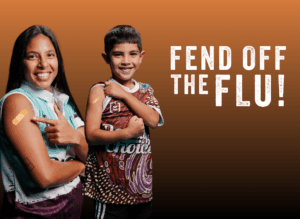Giving and getting support
Quitting is easier when you’ve got the right support.
Learn how to get and give support.
Getting support
A deadly support network will include support from both professionals and your Mob.
Professional Support
Don’t be shame asking for support when you need it.
Getting help from Quitline (13 78 48) or your local Community Controlled Health Service is a great way to start your quit journey.
Clinics and Quitline can provide a variety of support, including:
- A quit plan or program
- Access to NRTs and other quit aids
- Opportunity to talk to Aboriginal and Torres Strait Islander counsellors
- Ongoing support during your quit journey
- Specialised support for mums and partners at all stages of pregnancy (including pre-inception and post-partum)
Find your nearest clinic or contact Quitline on 13 78 48.
Your Mob
Asking friends and family to help you through your quit journey is a deadly way to create a support network that understand you and your needs.
- It gives them an understanding of why you’re quitting
- It helps you stay on track
- It helps you feel supported
It’s important to identify why you’re quitting, as it can help your Mob to understand your why and may inspire them to do the same.
Here are some reasons why you could be quitting:
- Your health
- The health of your Mob
- You are trying for/or are having a baby and want to have a healthy pregnancy, and smoke-free future for bub
- Your finances
- To be a leader in your community
- The environment
- To acknowledge culture and Our Ways
Yarning to your Mob
Start the conversation and be open to any questions they may have. Here are some ways you can start the conversation with your Mob:
“Hey you Mob, I wanted to yarn to you about my smoking. I have quit smoking but could use your help staying on track.”
“Hey bala, would you mind not smoking or vaping near me for a while? I’ve quit and could use your support quitting for good.”
“Sis, I want to quit the smokes so I can create a healthier life for my jarjum. Can you help keep me distracted when I have a craving?”

If your Mob and support network want to help you on your quit journey, encourage them to read the giving support section below to see the different ways they can support.
Giving Support
A solid support network is one of the most important factors of a successful quit journey.
There are so many ways you can support your Mob who are quitting the smokes.
1. Help them find support
2. Your attitude matters
Be empathetic and understanding
It is important to see things from a smoker or vapers point of view and acknowledge their feeling and emotions to better support them.
Be respectful
Remember that this is their journey. Being positive and non-judgmental is important. Negativity, lecturing and nagging can make quitting more difficult by adding unnecessary and unwanted pressure to the person quitting.
Be supportive
Positive support is a great way to help the person quitting stay on track. Quitting is a difficult journey, navigating nicotine withdrawals, understanding and avoiding triggers, and experiencing a change in identity from a smoker to non-smoker can be stressful and hard. Those quitting are likely to experience mood swings and be irritated easily, but it’s important to remember this won’t last.
Believe in them
Believing in your Mob who are quitting will help them to stay strong and push through. Don’t shame them or question their ability to quit – even if they have tried before.
Be encouraging
Often it takes a few attempts to quit smoking for good. Stay positive and encourage them to get back on track if they relapse or fall into old habits.
Be there for them
Quitting can be a long journey. Reassure the person quitting you will be there for them however long it takes.
3. Change your environment
- Commit to making your own spaces smoke-free places. Create smoke and vape-free rules for your home and car. This will make it more difficult for the person quitting the smokes or vapes to smoke when with you.
- Remove any reminders of smoking or vaping from your environment to reduce triggers and any reminders of smoking or vaping (for example: ash tray, lighters, old vapes and cigarette butts).
- Clean your home and car to remove the smell of smoke or any vape residue.
4. Help with healthy food and drink choices
- Have healthy snacks for the person quitting, so they have a healthy option to reach for when they need a distraction.
- Encouraging your person quitting to avoid grog is important. For many, it will trigger the urge to smoke, so avoiding alcohol altogether is a good strategy.
- Encourage your person quitting to reduce their caffeine intake (including coffee, tea and energy drinks) as caffeine has a stronger effect when a person quits.
5. Organise distractions
- Organise some deadly activities for your Mob you are quitting. Get out on Country, get active, go to a game or spend some time with your Mob.
- Help your Mob manage their stress levels. This can include helping them come up with a list of activities they can do to reduce stress and help them identify potentially stressful situations and come up with a plan to manage it.
- Celebrate the wins! Remember to acknowledge and celebrate the small, and major milestones they achieve.
Remember, your Mob may need a few attempts on their quit journey. Encourage your loved one quitting to be strong and try again. Positive support and encouragement is important.
Ready to quit?
You can find quit support from a variety of sources.
Local CCHS
Your local Community Controlled Health Service will be able to offer a variety of support for the entire duration of your quit journey. This includes access to NRTs, being able to have a confidential yarn, culturally relevant support, Quitline referrals and quit programs.
Find your nearest CCHS.
Your GP
Your GP is able to give you more information on the benefits of quitting, as well as prescribe and recommend NRTs.
Contact your GP to discuss further.
Quitline
Accessing Quitline is an easy way to access quit support from wherever you are in Australia. Quitline offers free and confidential specialised support programs for Aboriginal and Torres Strait Islander peoples.

















